Massive Machine Type Communication Market Size
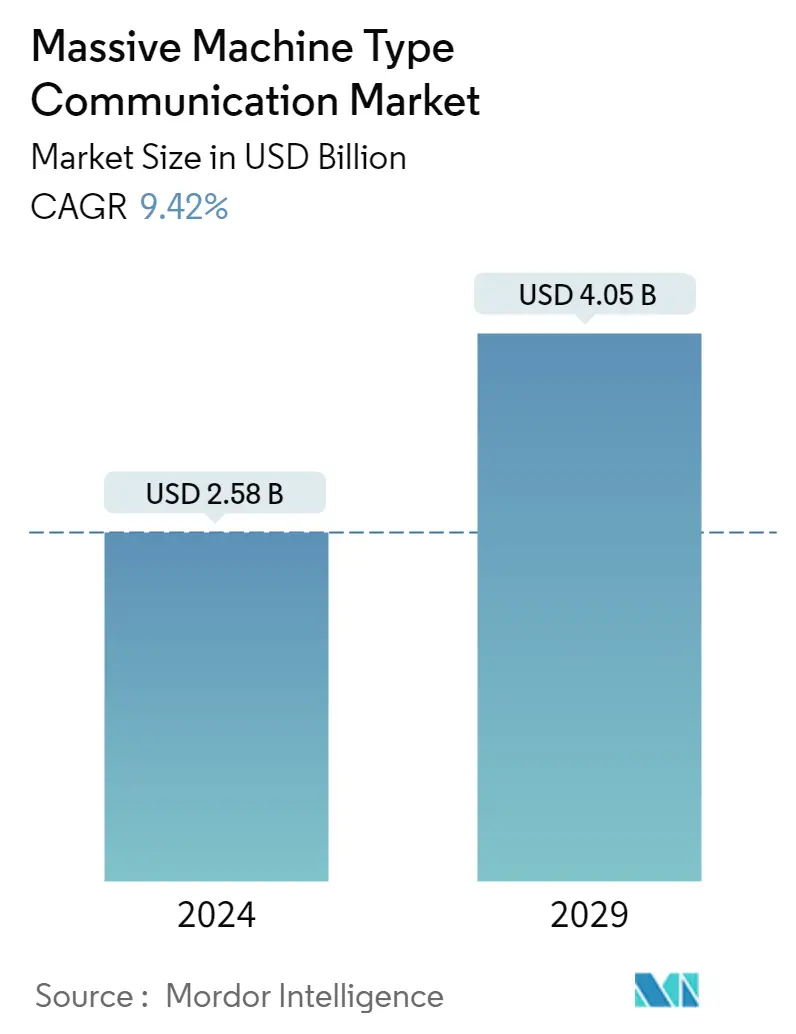
| Study Period | 2018-2028 |
| Market Size (2023) | USD 2.36 Billion |
| Market Size (2028) | USD 3.70 Billion |
| CAGR (2023 - 2028) | 9.42 % |
| Fastest Growing Market | North America |
| Largest Market | Asia Pacific |
Major Players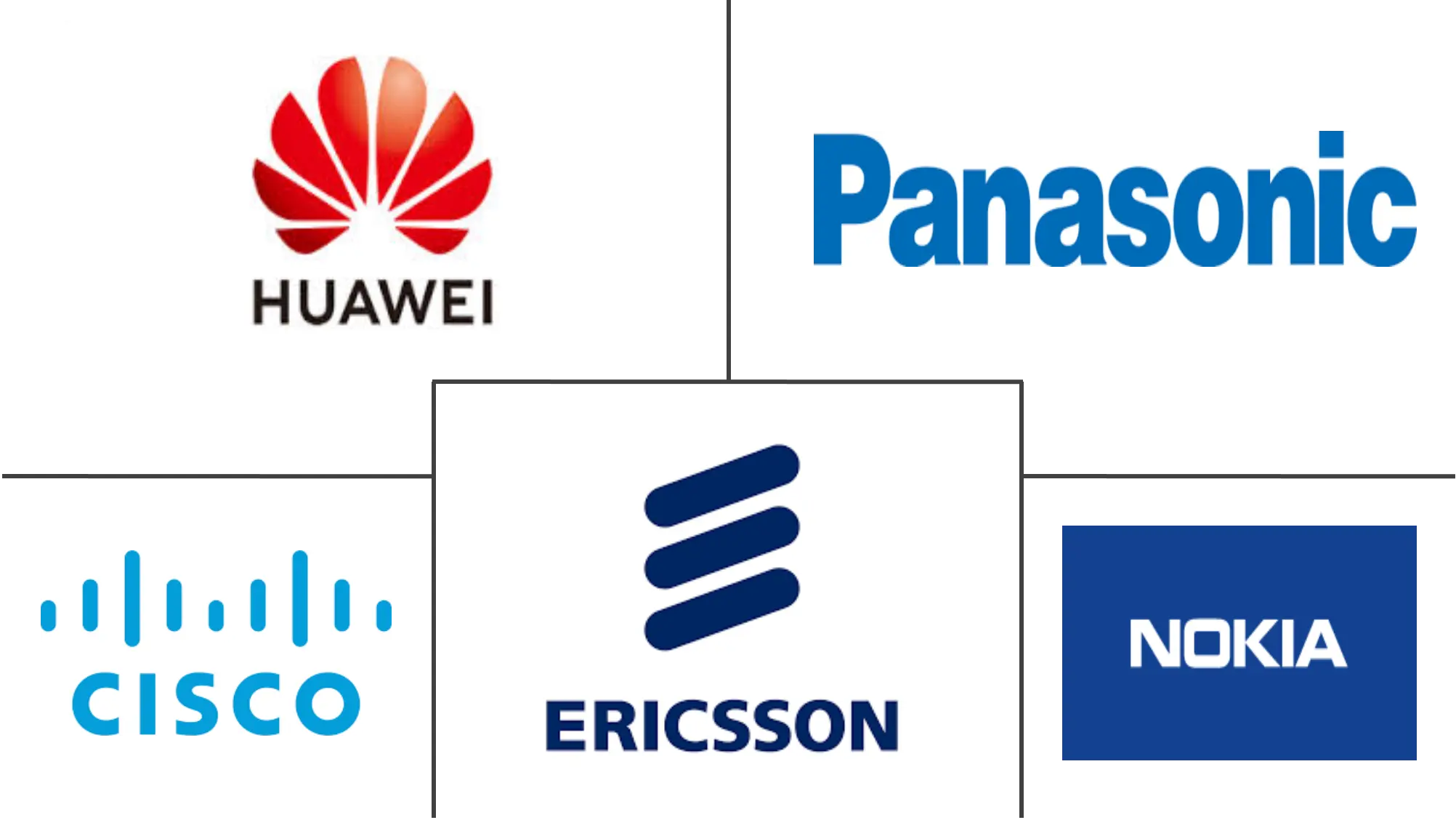
*Disclaimer: Major Players sorted in no particular order |
Need a report that reflects how COVID-19 has impacted this market and its growth?
Massive Machine Type Communication Market Analysis
The Massive Machine Type Communication Market size is expected to grow from USD 2.36 billion in 2023 to USD 3.70 billion by 2028, at a CAGR of 9.42% during the forecast period (2023-2028).
Machine-type communication (MTC) is a fundamental technology to realize the concept of a fully connected world in the fifth-generation (5G) Internet of Things (IoT).
- The development of the massive machine-type communication (mMTC) industry is being fueled by several key factors, such as the rising demand for fully automated processes, connected devices, wireless connectivity, rising investment in smart city projects, and investment and development in next-generation mobile network infrastructure. Smart cities are expanding globally as a result of urbanization, which is fueling market growth. According to UN forecasts, 404 million urban people in India, 212 million in Nigeria, and 292 million in China will be added to the current population by 2050.
- By 2023, the Japanese multinational holding corporation SoftBank planned to install 11,210 5G base stations. In addition, growing funding for smart city initiatives in this region, such as Asia-Pacific, contributes significantly to the expansion of mMTC implementation. The foundation of the smart city is massive machine-type communication, which permits machine-to-machine communication without requiring human input.
- Future 5G networks will likely be based on the heterogeneity of devices, technologies, and architectures, including IoT, UAVs, cloud and edge computing, etc. There would be a massive roll-out of IoT/MTCDs; these devices' simultaneous and unpredictable access will cause congestion and overload in 5G and beyond networks.
- However, the proliferation of MTC devices (MTCDs) propels serious challenges to the current cellular networks due to their huge number, particularly in ultra-dense scenarios like stadiums, concerts, hotspots, and flash crowds.
- The COVID-19 pandemic harmed the world economy. Lockdowns at the national level and social segregation standards in several nations severely impacted several businesses, including the mMTC sector. Since it was unclear how long the lockdowns would last, many 5G technology suppliers were under pressure, making it challenging for the major industry participants to predict when the mMTC market would recover.
Massive Machine Type Communication Market Trends
Energy Holds a Dominant Position in the Massive Machine Type Communication Market
- The characteristics of 5G wireless technology, such as massive machine type communication (MTC) and ultra-reliable and low-latency communication (URLLC), transform how energy utility companies operate. Distributed intelligence and control systems for substations to regular drone inspection of distribution and transmission lines utilizing 5G enhance smart grid projects to provide next-generation customer service.
- By the end of this decade, there will likely be 235 million tons of carbon emission annually, and electric energy consumption is expected to be 414TWh. A significant portion of global carbon emissions is from information and communication technology. Green communication is necessary for environmental protection to achieve energy efficiency in wireless networks.
- According to Global Carbon Project, In 2021, oil burning in the United States resulted in carbon dioxide emissions of 2.2 billion tons (GtCO2). China came second with 1.7 GtCO2, higher than any other nation that year. Oil emissions have decreased by more than 15% in the United States since 2005. In contrast, China's oil emissions have soared by more than 100%.
- It is one of the challenges of 5G networks to improve the energy efficiency of battery-constrained devices and should adopt techniques for environmental protection. Energy harvesting is a technique to enable the devices to power their services through energy harvested from renewable energy sources like wind and sun. Energy harvesting and green communication are essential for the MTCDs and BSs and aggregating devices like smartphones, drones, etc.
- There are several natural sources for energy harvesting. However, it is required to efficiently harvest the energy from these sources. Electromagnetic radiation, vibration, temperature, sunlight, wind, motion differences, RF, and the like can harvest energy into UAVs and wireless devices (smartphones and MTCDs).
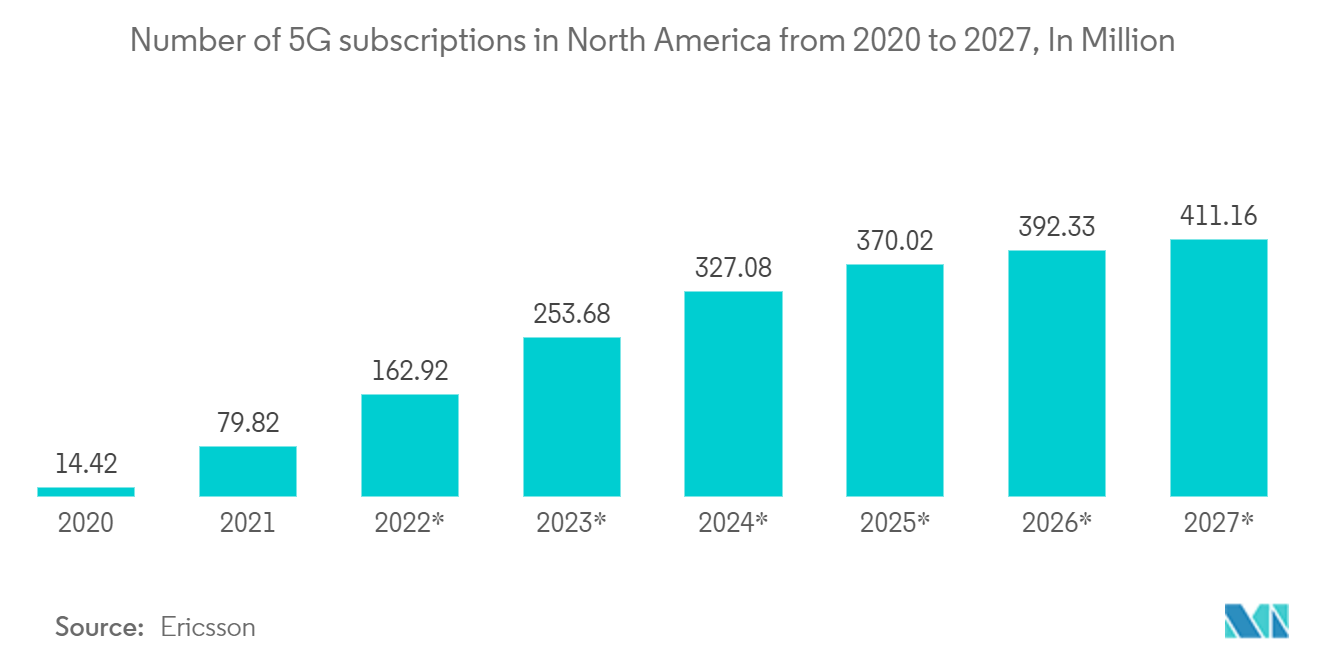
North America Holds a Dominant Position in the Massive Machine Type Communication Market
- The Massive Machine Type communication growth in North America is driven majorly by the high demand for faster connectivity and better internet experience. Some of the most significant investments in deploying Massive Machine Type Communication growth network infrastructure are materializing in North America. For instance, in May 2022, one of Canada's leading telecom firms, Telus, pledged to invest USD 70 billion in mobile network infrastructure nationwide by 2026.
- Market expansion in the region is anticipated to be aided by significant government spending in the region's healthcare system. For instance, in October 2022, Xochitl Torres Small, the Under Secretary for Rural Development at the U.S. Department of Agriculture (USDA), stated that the USDA awarded funds totaling USD 110 million to upgrade healthcare facilities in rural areas. These awards will likely assist 208 rural healthcare groups in 43 states and Guam to expand vital services for nearly 5 million people.
- Additionally, the healthy development of the 5G-enabled Massive Machine Type Communication Market has been prompted by the rapidly rising demand for mobile phones that support faster data rates. For instance, according to Ericsson, North America will likely have approximately 411 million 5G subscriptions by 2027.
- Throughout the forecast period, it is anticipated that strong U.S. expenditures in developing smart cities, creating smart businesses, and building smart homes would help the North American regional market expand. The "Smart City Accelerator Program" was introduced in October 2022 by Honeywell and Accelerator for America to assist towns in creating customized smart city plans. The strategy calls for developing a "Smart City Vision" that includes resilience-focused objectives, establishing an operational framework to assist each city in managing and supporting various projects, defining projects and business models to accomplish particular objectives, and figuring out governance structures for smart cities.
- Furthermore, in May 2022, the Biden administration encouraged governors and other officials to begin the application process as it prepares to disburse USD 45 billion to guarantee that every US citizen has high-speed internet by about 2028.
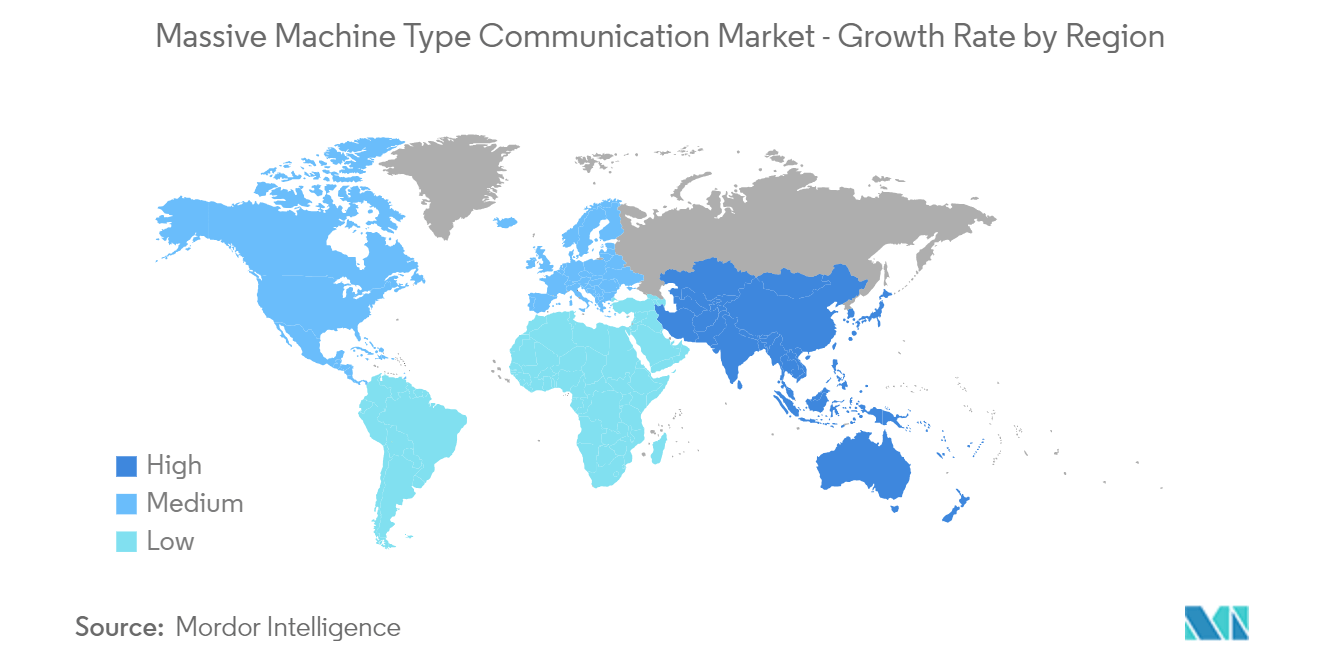
Massive Machine Type Communication Industry Overview
The Massive Machine Type Communication Market is moderately competitive and has several major players. In terms of market share, few of the major players currently dominate the market. The market is moderately fragmented, which is increasing the intensity of the market competition. As a result, it has become difficult for companies to survive in the market due to huge capital investments. Some prominent vendors in the market include Huawei Technologies Co., Ltd., Nokia Corporation, Cisco Systems, Inc., etc.
In September 2022, Standalone 5G is the "ultimate version of 5G," according to Orange. According to the operator, the technology was expected to increase the quality of service and network resilience control for commercial applications, maximizing the potential of 5G technology. With technologies like Ultra-Reliable Low Latency Communications (URLLC), Enhanced Mobile Broadband (eMBB), and Massive Machine-Type Communications (mMTC) services, the operator claimed Standalone 5G would likely also facilitate the future growth of value-added and on-demand offerings for Industry 4.0 and consumer markets.
In April 2022, The Tiger-3 satellite mission of OQ Technology, a 5G IoT connectivity firm situated in space, was launched from Space Launch Complex 40 on April 2022. (SLC-40). With ultra-reliable low latency communication (URLLC) and massive machine type communications (MTC), OQ's "cell tower within the satellite" technology sought to offer real-time worldwide connectivity for applications in remote and rural locations.
Massive Machine Type Communication Market Leaders
Huawei Technologies Co., Ltd.
Telefonaktiebolaget LM Ericsson
Nokia Corporation
Cisco Systems, Inc.
Panasonic Corporation
*Disclaimer: Major Players sorted in no particular order
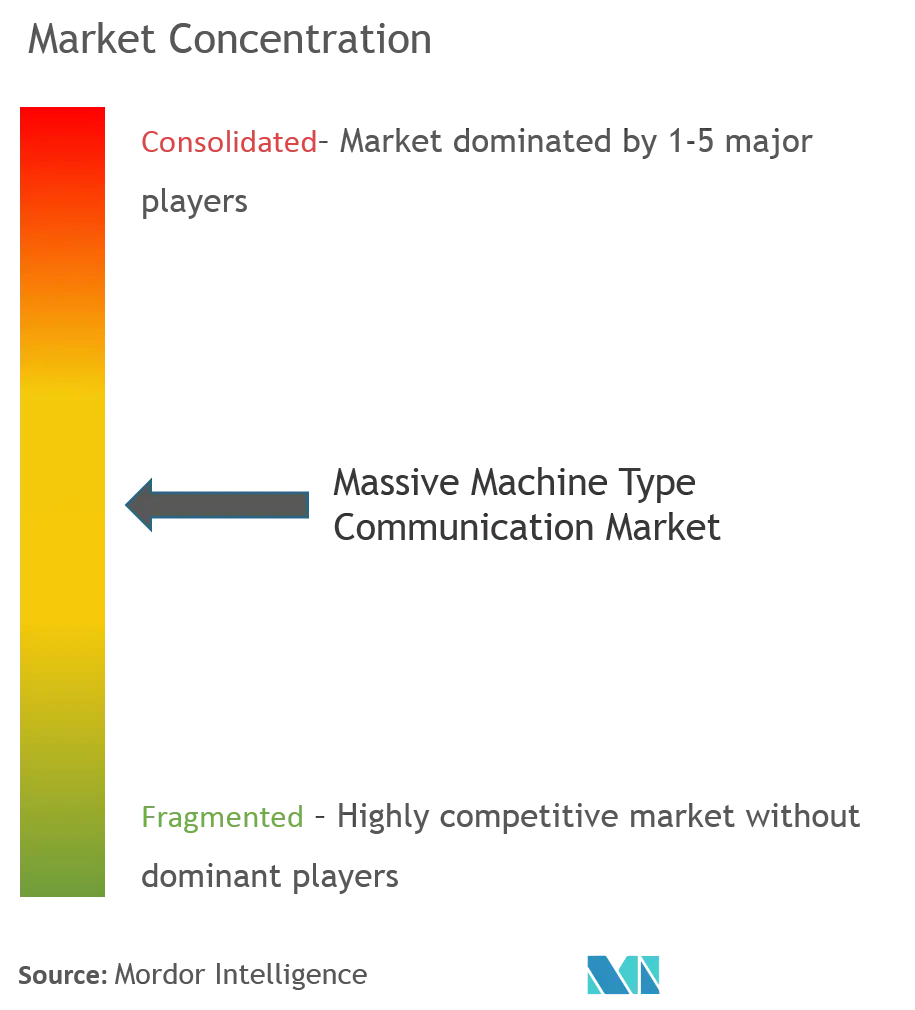
Massive Machine Type Communication Market News
- June 2022: Nokia launched the 5G Innov Lab solution in France to evaluate and incorporate potential 5G use cases. The 5G Living Lab, 5G Open Road, 5G mMTC, and 5G Maritime Perf platforms were all introduced by the BPI (Banque Publique d'Investissement) as part of the 5G Call for Projects. The Innov Lab 5G platform will likely enable it to demonstrate in real-world settings the power of 5G for all of these new use cases and support the projects of other 5G platforms.
- May 2022: A premier digital enabler, STC Bahrain, announced the opening of the initial 5G Standalone infrastructure in the United Kingdom. Huawei, a leader in global ICT solutions, collaborated on the launch of the standalone 5G network. The network's independence from the LTE or 4G layer defines it. The 5G Standalone network will likely handle both the public and enterprise categories, leading to more complexity 5G eMBB, mMTC, and URLLc services categories.
- October 2022: Through the A-Z Center in Thailand, ZTE Corporation and AIS cooperatively powered the 5G Advanced development to accelerate the digital revolution. A new engine for industrial digitalization is 5G. On the foundation of 5G eMBB, mMTC, and uRLLC, 5G-Advanced development was expected to keep improving network capabilities and integrate intrinsic AI to profoundly empower numerous industrial applications, including entertainment, security, health, home life, smart cities, and manufacturing.
Massive Machine Type Communication Market Report - Table of Contents
1. INTRODUCTION
1.1 Study Assumptions
1.2 Scope of the Study
2. RESEARCH METHODOLOGY
3. EXECUTIVE SUMMARY
4. MARKET INSIGHTS
4.1 Market Overview
4.2 Market Drivers
4.2.1 Augmented Demand for A Better Connectivity Experience
4.2.2 Necessity for Fast Internet Connectivity
4.2.3 Requirement of 5G in IoT
4.3 Market Restraints
4.3.1 Technology Limitations to Support Constant High-Speed Connections
4.3.2 Large Investment Involved in Developing 5G Infrastructure
4.4 Industry Attractiveness - Porter's Five Forces Analysis
4.4.1 Bargaining Power of Buyers/Consumers
4.4.2 Bargaining Power of Suppliers
4.4.3 Threat of New Entrants
4.4.4 Threat of Substitute Products
4.4.5 Intensity of Competitive Rivalry
4.5 Assessment of COVID-19 Impact on the Industry
5. MARKET SEGMENTATION
5.1 By Communication Channel Type
5.1.1 Wired
5.1.2 Wireless
5.2 By End-user Industry
5.2.1 Healthcare
5.2.2 Transporation & Logistics
5.2.3 Utilities
5.2.4 Energy
5.2.5 Other End-users (Agriculture, Industrial)
5.3 Geography
5.3.1 North America
5.3.2 Europe
5.3.3 Asia-Pacific
5.3.4 Rest of the World
6. COMPETITIVE LANDSCAPE
6.1 Company Profiles
6.1.1 Huawei Technologies Co., Ltd.
6.1.2 Telefonaktiebolaget LM Ericsson
6.1.3 Nokia Corporation
6.1.4 Cisco Systems, Inc.
6.1.5 Panasonic Corporation
6.1.6 Intel Corporation
6.1.7 Qualcomm Incorporated
6.1.8 Telecom Italia
- *List Not Exhaustive
7. INVESTMENT ANALYSIS
8. MARKET OPPORTUNITIES AND FUTURE TRENDS
Massive Machine Type Communication Industry Segmentation
Massive machine type communication (MTC), also known as massive machine communication (MMC) or massive Machine to Machine communication, is a type of communication between machines over wired or wireless networks where data generation, information exchange, and actuation occur with minimal or no human intervention.
The Massive Machine Type Communication Market is segmented by Communication Channel Type (Wired, Wireless), End-user Industry (Healthcare, Transportation & Logistics, Utilities, Energy, and Other End-User Industries (Agriculture, Industrial)), and Geography (North America, Europe, Asia Pacific, Latin America, and Middle East and Africa). The market sizes and forecasts are provided in terms of value (USD) for all the above segments.
| By Communication Channel Type | |
| Wired | |
| Wireless |
| By End-user Industry | |
| Healthcare | |
| Transporation & Logistics | |
| Utilities | |
| Energy | |
| Other End-users (Agriculture, Industrial) |
| Geography | |
| North America | |
| Europe | |
| Asia-Pacific | |
| Rest of the World |
Massive Machine Type Communication Market Research FAQs
How big is the Massive Machine Type Communication Market?
The Massive Machine Type Communication Market size is expected to reach USD 2.36 billion in 2023 and grow at a CAGR of 9.42% to reach USD 3.70 billion by 2028.
What is the current Massive Machine Type Communication Market size?
In 2023, the Massive Machine Type Communication Market size is expected to reach USD 2.36 billion.
Who are the key players in Massive Machine Type Communication Market?
Huawei Technologies Co., Ltd., Telefonaktiebolaget LM Ericsson, Nokia Corporation, Cisco Systems, Inc. and Panasonic Corporation are the major companies operating in the Massive Machine Type Communication Market.
Which is the fastest growing region in Massive Machine Type Communication Market?
North America is estimated to grow at the highest CAGR over the forecast period (20221-2028).
Which region has the biggest share in Massive Machine Type Communication Market?
In 20221, the Asia Pacific accounts for the largest market share in Massive Machine Type Communication Market.
Massive Machine Type Communication Industry Report
Statistics for the 2023 Massive Machine Type Communication market share, size and revenue growth rate, created by Mordor Intelligence™ Industry Reports. Massive Machine Type Communication analysis includes a market forecast outlook to for 2023 to 2028) and historical overview. Get a sample of this industry analysis as a free report PDF download.
